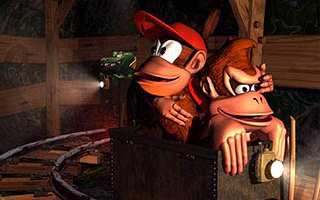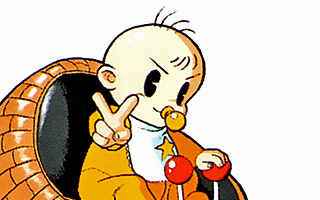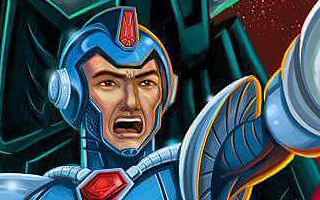Atari 7800
Top 10 Best Atari 7800 Games of All Time!
After the Atari 5200 failed to meet sales expectations, Atari conceived a new console in attempt to retain market supremacy in the face of mounting pressure from the ColecoVision. Working with General Computer Corporation, Atari announced the 7800 ProSystem in 1984. Even though the 7800 was compatible with Atari 2600 games and came with a controller that actually worked, it still failed to make an impression. By the time the 7800 was released nationwide, the Nintendo Entertainment System had redefined the entire business and made it impossible for the 7800 to gain a foothold. Ironically, Atari had previously turned down an offer that would have granted them exclusive distribution rights for Nintendo’s console outside of Japan. After the 2600 had reigned supreme for the better part of a decade, Atari faced back-to-back failures with the 5200 and 7800. They finally struck gold again when they released the Jaguar in 1993… or maybe not.
10
Commando
1989

Commando is a war-themed “run and gun” game that’s played from an overhead view. The game revolves around a soldier named “Super Joe” who essentially acts as a one-man-army after being dropped off in a harsh jungle environment. Joe can fire his machine gun in eight different directions and blast through obstacles with hand grenades. He can also find an upgraded gun that allows him to shoot faster and a knife upgrade that essentially lets him kill enemies by running into them. Although survival is the number one objective in the game, players are also encouraged to rescue POWs along the way. Commando looks fantastic for a 7800 game and the gameplay is arguably better than it is in the NES version. The game sounds better than typical 7800 games too, and it even uses a special built-in sound chip. The Atari 7800 was well known for a strong library of classic arcade games, but the console was lacking in the area of contemporary titles. The overwhelming popularity of the NES coupled with Nintendo’s aggressive licensing terms made it very hard for Atari to secure high-profile releases for the 7800. It was a real treat to see a game like Commando appear on the system.
9
Robotron: 2084
1987

In Robotron: 2084, players assume the role of a mutant defending against swarming enemy robots. When one wave of robots is defeated, you will progress to increasingly faster waves of hostile enemies. While most of the game involves running around and blasting everything in sight, you can also rake in some bonus points by rescuing humans that roam around aimlessly. Robotron stood out in the arcades because of an innovative “dual joystick” control scheme that allowed players to move and shoot in different directions. While this setup may not seem all that impressive in an era where dual analog sticks are standard on every controller, it was a big deal in the early ’80s and made for a frantic gaming experience the likes of which had never been seen before. Thankfully, the 7800 port allows you to use two controllers simultaneously to emulate the feel of the arcade game. Holding two joysticks at the same time can be unwieldy, but Robotron still stands strong as one of the best titles available for the system. Needless to say, the Robotron formula was incredibly addicting and its influence can still be seen today in games like Geometry Wars.
8
Alien Brigade
1990

Alien Brigade is one of a handful of 7800 games that supports Atari’s XE Light Gun. Players are not given control over the movement of their character in the game, and are focused entirely on shooting things. The objective in Alien Brigade is to rescue captive prisoners while doing battle with alien forces and legions of possessed soldiers. Players will have to contend with enemy tanks and helicopters, but they have to be careful not to accidentally shoot any of the hostages in the process. During the game, players will visit various locations that include an enemy base, a heavily-armed river bank, an underground mine, and a mountain top. One stage even involves a massive underwater melee! Exclusive games on the Atari 7800 were few and far between, but Atari went all out with Alien Brigade. The graphics were a clear step above most games on the console and the attention to detail was pretty surprising. Aliens melt when they are shot, limbs can be blasted off, and water-based enemies will even hold their nose before falling into the drink. It shouldn’t be surprising to learn that Alien Brigade was one of the biggest games commercially released for the 7800.
7
Ninja Golf
1989

As its name implies, Ninja Golf follows the exploits of a ninja golfer. The “golf” aspects of the game are extremely simplified, and players only have one club at their disposal. Most of the game revolves around the dangers of running to the ball between each swing. The side-scrolling “ninja” portions of the game basically amount to a Kung Fu knock-off. Rival ninjas are constantly running in from the sides of the screen, and players have to dispose of them with various karate kicks. (They’ll also find helpful items like throwing stars and potions to help them along the way.) Additionally, players will encounter various animals in accordance to where the ball is hit. Angry gophers populate the fairway, mutant frogs hang around in the rough, deadly snakes inhabit the sand traps, and the water hazards are infested with sharks. (That’s right, the ninja actually walks through the water hazards in order to retrieve his ball!) After reaching the green, players are tasked with killing a fire-breathing Chinese myth dragon and the golf aspects of the game are basically thrown out the window. Admittedly, Ninja Golf is somewhat repetitive and the initial humor wears off after a while; but it still has a highly creative concept and it’s a game that can only be played in the 7800.
6
Donkey Kong Junior
1988

Donkey Kong Jr. was one of the most varied single-screen platform games of all time and ranks as one of the most ambitious sequels ever created. After striking gold with the original Donkey Kong, Nintendo went back to the drawing board for the sequel. Donkey Kong Jr. had the same basic premise as the original, and players were given the same objective of working their way to the top of the screen in each stage. The game featured a new playable character though, and the stages themselves were completely unique. Donkey Kong Jr.’s climbing abilities added a lot of depth to the standard “walking and jumping” format that the original game employed. The Atari 7800 version doesn’t look or sound as nice as the arcade game, but the core play mechanics were translated faithfully and all four stages from the arcade were included. It’s surreal to see Nintendo games on an Atari system, but it must have been comforting for hardcore Atari fans to be able to play a game on the 7800 in which Mario was portrayed as the villain.
5
Galaga
1987

When discussing great shoot ’em ups from the classic era, Galaga should immediately come to mind. The game was even more colorful than Galaxian, and more variety could be seen in the enemy formations as well. The bonus stages and boss battles were welcome additions, while enemy tractor beams, alien abductions, and the ability to rescue captured ships added an element of drama to the genre. Versions of Galaga were released on the MSX and SG-1000 in Japan, but the Atari 7800 version was the first home port to hit American store shelves. Fans of classic arcade games had reason to be excited, as they had been waiting for six years to play the game at home. The Atari 7800 version certainly looks fantastic, and after a few minutes with the game I was ready to declare it as the greatest game on the system. Unfortunately, the game is hampered by severe slowdown in later stages. It’s not immediately noticeable in the beginning, but it becomes increasingly apparent as the game progresses. Ultimately, this slowdown prevents Galaga from being the “killer app” that it could have been. It’s still a great game in its own right, but it’s not an acceptable replacement for the arcade game.
4
Food Fight
1987

In Food Fight, players assume the role of a young boy with the unfortunate name of Charley Chuck and are given the simple goal of obtaining and eating an ice cream cone before it melts. In order to reach the ice cream, you first have to navigate past four disgruntled chefs who will try to pelt you with food. When you are unable to outrun these hostile chefs, you will have to ward them off by using various food items as weapons. Depending on the level, you will get to use pies, watermelons, peas, bananas, and tomatoes as ammunition against your culinary foes. The game also has an innovative “instant replay” feature that is implemented during rounds that end in a particularly close manner. The game can get a little repetitive, but it’s old school arcade gaming at its finest. Besides, it’s hard not to be intrigued by a kid who likes ice cream so much that he will unhinge his jaw to eat it. Food Fight on the Atari 7800 is an especially noteworthy title, as it was the only console version of the game ever released. The Atari 7800 wasn’t exactly known for a deep library of exclusive games, so it’s really easy to appreciate an original game like Food Fight.
3
Centipede
1987

While most shoot ’em ups in the early ’80s had you defending the planet against invading insect-like aliens, the goal of Centipede is to defend a garden against swarms of actual insects. Spiders will jump down toward the players, fleas leave obstructive mushrooms in their path, and scorpions have the ability to poison said mushrooms. Naturally, centipedes are your main antagonists, and they attack in 12 distinctive waves. When you shoot the centipedes, their segments will split apart and move independently of one another. Despite its repetitive nature, Centipede is so action-packed that it never gets boring. This port is extremely close to the arcade original, but the lack of trackball support was an unfortunate oversight. Having said that, the 7800 joysticks do a surprisingly good job of emulating the acceleration aspects of the trackball. What makes the 7800 version special is its two player modes. Players can either compete against each other or join forces in the incredibly fun cooperative mode. These two player modes bring the game to a new level and make the Atari 7800 port a “must own” game for fans of the original. Subsequent versions for the XBOX and PS2 didn’t even offer the same two player support.
2
Joust
1987

In Joust, players saddle up on a flying space ostrich and test their bravery against evil alien knights who ride atop giant buzzards. To best their foes, players must collide with them while at a higher altitude than they are. After eliminating your rivals, it’s important to quickly retrieve eggs that drop before they hatch deadlier enemies. In addition to your rival knights, you’ll also have to contend with seemingly invincible pterodactyls and fire trolls that attempt to drag you down into the lava when you get too close to them. If things get too difficult, a second player (riding on an emu) can help out. Because you are also awarded points for destroying human opponents, the cooperative gameplay can also become extremely competitive. The pacing of Joust is decidedly faster than most arcade games from the early ’80s, and understanding how to use your bird’s momentum to your advantage requires real skill. The standard 7800 controller is not exactly contusive to the arcade-based gameplay, but you can always use a 2600 joystick (or a Sega Genesis controller) as an alternative. In many ways, Joust helped define what multiplayer gaming was all about. All things considered, GDC did a fantastic job of bringing the arcade game home to the Atari 7800.
1
Ms. Pac-Man
1987

Pac-Man was one of the most iconic arcade games of the ’80s, but its follow-up improved upon it in several meaningful ways. Ms. Pac-Man featured new bonus items, new mazes, and a handful of delightfully charming cutscenes that outlined the relationship between Pac-Man and his lovely lady. The gameplay itself was also more intense and the characters moved a lot faster. The Atari 7800 version of Ms. Pac-Man is an excellent port of the original arcade game. The perspective was squashed down somewhat in order to reconcile the differences between arcade monitors and standard television sets; but, other than that, the game looks and feels exactly like it should. It even features the same intro sequence that was seen in the arcades! Ms. Pac-Man took a while to hit store shelves and didn’t have the same impact in 1987 as it would have had a few years earlier, but it’s still a fantastic game that stands the test of time. Versions of Ms. Pac-Man have been released on dozens of gaming platforms over the course of the past few decades, so I know it’s not the most inspired choice for the number one position on this list. Rest assured, Ms. Pac-Man is a very worthy game and deserves to be recognized as the best game on the system.





Do you agree with this list? Let us know what you think by leaving a comment below. Your opinion matters!